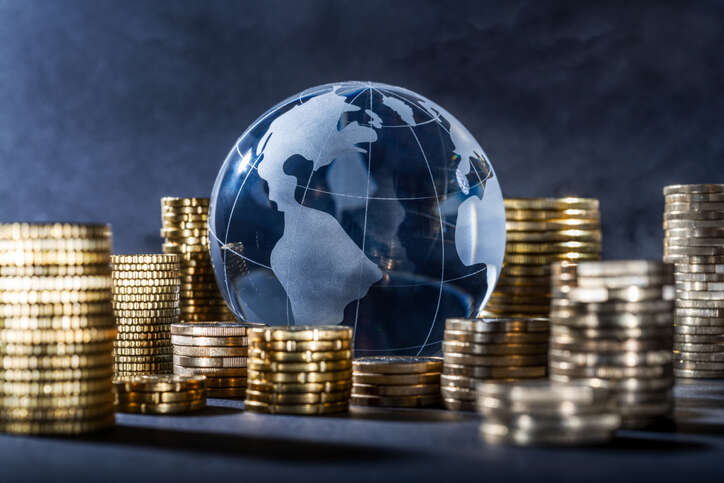
Money is the lifeblood of modern economies, serving as the lubricant that facilitates transactions and drives economic activity. But have you ever wondered just how much money there is in the world? “How Much Money Is There in the World: A Comprehensive Exploration” embarks on a journey through the annals of monetary history and contemporary financial systems to answer this intriguing question. In this comprehensive exploration, we delve deep into the origins of money, trace its evolution from barter to the digital age, and examine the intricate web of global monetary systems.
Categories of money

A. Physical money
- Coins: Coins are physical tokens of currency, typically made of various metals. They are essential for day-to-day transactions, allowing people to make small purchases conveniently. Coins often have different denominations, making it easy to give and receive change.
- Banknotes: Banknotes, commonly referred to as paper money, are issued by governments and central banks. They are typically made from paper or polymer materials and serve as a widely accepted medium of exchange. Banknotes represent a promise from the issuing authority to pay the holder the specified amount on demand.

B. Digital money
- Bank deposits: Digital money includes funds held in bank accounts, which are essentially digital ledger entries. There are two primary types of bank deposits: demand deposits (checking accounts) and time deposits (savings accounts). Demand deposits allow for easy access to funds, while time deposits have restrictions on withdrawals for a predetermined period.
- Cryptocurrency: Cryptocurrency is a revolutionary form of digital money. It operates on a decentralized ledger technology called blockchain, which ensures transparency and security. Cryptocurrencies like Bitcoin and Ethereum have gained popularity for their potential as alternative assets and mediums of exchange. They offer borderless transactions and security features like cryptography.
- Electronic payments: Electronic payments encompass a wide range of non-cash transactions. This category includes debit and credit card payments, wire transfers, and mobile payment methods like Apple Pay and PayPal. Electronic payments have become increasingly prevalent in modern economies due to their convenience and efficiency.

Measuring the global money supply
A. Money aggregates
- M0, M1, M2, M3
The global money supply is often categorized into different money aggregates (M0, M1, M2, M3) based on liquidity and accessibility. These aggregates help economists and policymakers analyze the money supply’s various components and their impact on the economy.
- M0: Represents the most liquid forms of money, including physical cash and central bank reserves.
- M1: Includes M0 plus demand deposits, which can be quickly converted into cash.
- M2: Adds savings accounts and small-time deposits to M1, providing a broader view of money supply.
- M3: Further expands M2 to include large time deposits and institutional money market funds, offering a more comprehensive assessment of money in the economy.
M0 (Narrow Money)
M0, also known as “narrow money” or “the monetary base,” represents the most liquid forms of money in an economy. It includes:
- Physical currency (coins and banknotes): This comprises all the physical cash in circulation, including coins and paper banknotes. M0 represents the total value of cash held by individuals, businesses, and financial institutions. Central banks are responsible for issuing and regulating physical currency.
- Central bank reserves: M0 also includes the reserves held by commercial banks in their accounts at the central bank. These reserves are a crucial component because they serve as the foundation for the broader money supply. Commercial banks are required to hold a portion of their deposits as reserves at the central bank, and these reserves can be used for interbank settlements and lending.
M0 provides a snapshot of the most liquid and immediately spendable forms of money in an economy. It serves as the foundation upon which broader money aggregates are built.
M1 (Narrow money + demand deposits)
M1 is a broader measure of the money supply compared to M0. It includes all the components of M0 and adds:
- Demand deposits (Checking accounts): Demand deposits are bank accounts that allow depositors to withdraw funds on demand. These accounts are highly liquid and serve as a convenient means of payment for day-to-day transactions. Money in demand deposits is considered part of the money supply because it is readily available for use.
- M1 encompasses the most liquid forms of money available for immediate spending. It is often used to gauge the overall liquidity of an economy and is closely monitored by central banks and policymakers.
M2 (M1 + Savings deposits)
M2 is an even broader measure of the money supply and includes all components of M1 as well as:
- Savings deposits (Time deposits): Savings deposits represent funds held in accounts that typically pay interest but require depositors to leave their money with the bank for a specified period. While not as immediately accessible as demand deposits, they are still part of the broader money supply because they can be converted into spendable funds relatively easily.
- M2 captures a wider range of money that includes not only funds available for immediate use but also those held in interest-bearing accounts that can be accessed with relative ease. This measure provides a more comprehensive view of the money supply in an economy.
M3 (M2 + Large time deposits and Institutional money market funds)
M3 is the broadest measure of the money supply and includes all components of M2 as well as:
- Large time deposits: Large time deposits refer to sizable certificates of deposit (CDs) and time deposits that may have longer maturities. These are less liquid than other forms of money but still represent savings that can be converted into cash or used for spending.
- Institutional money market funds: This category includes money market mutual funds that are accessible to institutional investors. These funds invest in short-term, highly liquid assets and can be considered part of the broader money supply because they provide easy access to funds for these institutions.
M3 captures the widest range of money in an economy, including not only immediate spendable funds and savings but also large time deposits and funds accessible to institutional investors. It is often used to assess the overall health and stability of the financial system.
B. Central banks’ role
- Money creation process: Central banks play a pivotal role in the money supply through the money creation process. They control the issuance of physical cash and regulate the digital money supply by setting interest rates, which influence lending and borrowing. Central banks can inject money into the economy through mechanisms like open market operations, thereby affecting the overall money supply.
- Monetary policy: Monetary policy refers to central banks’ actions and decisions to manage the money supply and influence economic conditions. They use tools like interest rate adjustments and quantitative easing (buying financial assets) to achieve economic objectives, such as price stability and economic growth.
C. Global financial institutions
- International monetary fund (IMF): The International Monetary Fund (IMF) plays a role in stabilizing the global monetary system. It provides financial assistance to countries facing balance of payments problems and offers economic analysis and policy advice to promote international monetary cooperation.
- World bank: The World Bank focuses on providing financial and technical assistance to developing countries for projects that aim to reduce poverty, promote economic growth, and improve living conditions. While it does not directly manage the money supply, its work indirectly influences global economic conditions.
Components of the global money supply
A. Currency in circulation
- Amount of physical currency: The amount of physical currency in circulation varies by country and depends on factors like population, economic activity, and currency denomination preferences. Central banks monitor and manage the volume of physical currency to ensure it meets the needs of the economy.
- Factors affecting currency circulation: Several factors influence the circulation of physical currency, including cashless payment trends, the use of ATMs, and government policies regarding the production and distribution of banknotes and coins.
B. Bank deposits
- Demand deposits: Demand deposits, found in checking accounts, allow account holders to access their funds on demand. These accounts are used for everyday transactions, and the money is typically highly liquid.
- Time deposits: Time deposits, often held in savings accounts, require account holders to leave their money with the bank for a specified period. In return, they may earn interest on their deposits. Time deposits are less liquid than demand deposits but offer potential interest income.
C. Digital payments
- Electronic transactions: Electronic transactions include various forms of digital payments made using electronic devices, such as credit card purchases, online banking transfers, and peer-to-peer payment apps. These transactions have become increasingly popular due to their speed and convenience.
- Mobile payments: Mobile payments involve using smartphones or other mobile devices to make transactions. Services like Apple Pay, Google Pay, and mobile banking apps have gained traction, enabling users to make purchases, send money, and manage their finances on the go.
D. Cryptocurrency market
- Bitcoin: Bitcoin, the first and most well-known cryptocurrency, was created in 2009 by an anonymous person or group known as Satoshi Nakamoto. It operates on a decentralized blockchain and has gained popularity as a digital store of value and a medium of exchange.
- Ethereum: Ethereum is a blockchain platform that supports not only its native cryptocurrency, Ether (ETH), but also smart contracts. These self-executing contracts enable a wide range of decentralized applications (DApps) and have expanded the use cases for blockchain technology.
- Other Altcoins: Beyond Bitcoin and Ethereum, there are thousands of other altcoins in the cryptocurrency market. These alternative cryptocurrencies offer various features and use cases, including privacy coins, stablecoins, and tokens used within specific ecosystems.
Global money supply trends
A. Historical perspective
- Evolution of money: The concept of money has evolved over millennia, from barter systems to the use of physical commodities like gold and silver. It further transformed with the introduction of paper money and has now entered the digital age with cryptocurrencies.
- Gold standard era: In the past, many countries operated on the gold standard, where the value of their currency was tied to a specific quantity of gold. This system provided stability but limited flexibility in monetary policy.
B. Recent trends
- Growth of digital payments: Recent years have seen a significant growth in digital payments. This trend is driven by advancements in technology, changing consumer preferences, and the convenience of cashless transactions.
- Impact of financial crises: Financial crises, such as the 2008 global financial crisis, have had a profound impact on the money supply. Central banks responded with policies like quantitative easing (buying financial assets) to inject liquidity into the economy and stabilize financial markets.
Factors affecting the money supply
A. Central bank policies
- Interest rates: Central banks use interest rates as a primary tool to influence the money supply. When they lower interest rates, borrowing becomes cheaper, leading to increased spending and investment. Conversely, raising interest rates can reduce borrowing and control inflation.
- Quantitative easing: In times of economic stress, central banks may employ quantitative easing (QE) by purchasing financial assets like government bonds. This injects money into the economy, aiming to lower long-term interest rates and stimulate economic activity.
B. Economic events
- Inflation: Inflation is the rate at which the general level of prices for goods and services rises, eroding the purchasing power of money. Central banks aim to control inflation within a target range to ensure price stability.
- Recession: Recession is a period of economic decline characterized by reduced consumer spending, decreased business activity, and high unemployment. Central banks may use monetary policy tools to counteract recessionary trends by encouraging borrowing and spending.
C. Technological advancements
- Fintech innovations: Fintech (financial technology) innovations have led to the development of new payment methods, lending platforms, and financial services. These innovations can alter the way money is managed, transferred, and accessed.
- Cryptocurrency adoption: The adoption of cryptocurrencies like Bitcoin and Ethereum has introduced a new dimension to the global money supply. These digital assets provide alternatives to traditional currencies and offer unique features such as decentralization, security, and borderless transactions.
Challenges in measuring global money
A. Informal economies
Informal economies, where transactions occur outside the formal banking system, pose challenges in accurately measuring the money supply. Cash-based transactions in these economies may not be fully accounted for.
B. Shadow banking
Shadow banking refers to financial activities conducted by entities outside traditional banks. It can include money market funds and other non-bank financial intermediaries. These activities can influence the broader money supply but are less regulated.
C. Cryptocurrency regulation
The rapid growth of cryptocurrencies has raised questions about regulation. Governments and regulatory bodies are working to establish frameworks for the taxation, trading, and use of cryptocurrencies, which can affect their integration into the broader money supply.
In conclusion, this comprehensive exploration into the world’s money supply has revealed the intricate tapestry of financial systems that underpin our global economy. We began by tracing the origins of money from rudimentary barter systems to the complex digital currencies of today, recognizing the pivotal role of money as a medium of exchange, unit of account, and store of value throughout history. We delved into the measurements of money supply, its distribution across the world, and the influential role played by central banks.


